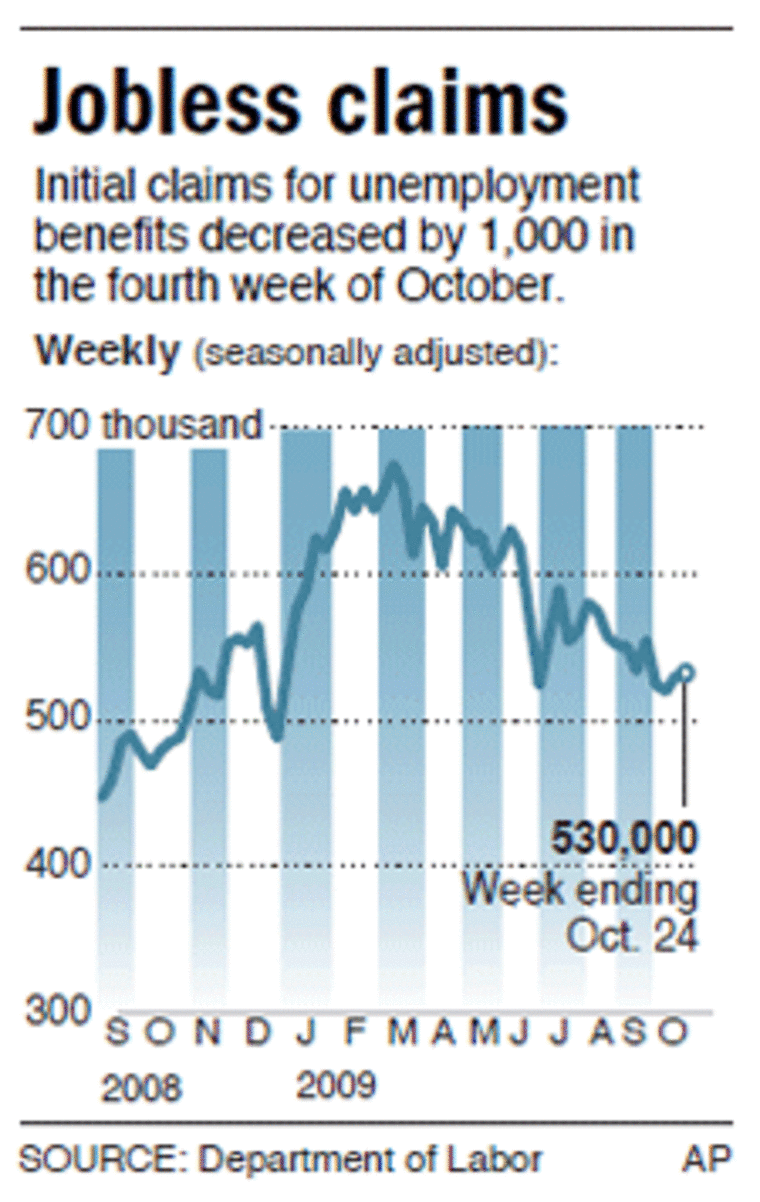The number of people claiming jobless benefits for the first time dropped less than expected last week, evidence that the labor market remains weak even as the economy is recovering.
The Labor Department said Thursday its tally of newly laid-off workers seeking unemployment insurance fell by 1,000 to a seasonally-adjusted 530,000. Analysts expected a steeper drop to 521,000, according to a survey by Thomson Reuters.
The report came on the same day the Commerce Department said the economy grew at a 3.5 percent pace in the July-September quarter, snapping a record streak of four straight quarterly declines. But the economy isn't growing quickly enough to spur much hiring.
Initial claims need to fall below about 450,000 to signal that employers are actually adding jobs, several economists said. Still, many saw some positive signs in the report.
The number of people continuing to claim unemployment insurance benefits dropped 148,000 to 5.8 million, a steeper fall than expected and the sixth straight decrease. Those figures lag initial claims by a week.
That doesn't include the nearly 4 million people receiving benefits from federal emergency programs during the week of Oct. 10, a decline of about 71,000 from the previous week. Many of those recipients likely are exhausting their benefits and falling off the rolls without finding jobs, some economists said.
The National Employment Law Project, an advocacy group for the unemployed, has projected that 1.3 million people will use up their benefits by the end of the year. Congress has added up to 53 extra weeks of support on top of the 26 typically provided by the states. The Senate is considering whether to provide another 14 to 20 weeks of emergency support for those about to run out.
About 52 percent of recipients in the past year have exhausted their regular state benefits, the highest proportion on records dating from 1972, according to Labor Department data.
But the decline in the total benefit rolls could also mean at least some are finding jobs.

The drop suggests "people are returning to work rather than shifting" from the regular program to emergency benefits, Zach Pandl, an economist at Nomura Securities, wrote in a note to clients.
Meanwhile, the four-week average of claims, which levels out volatility, fell for the eighth straight week to 526,250, its lowest level since early January. That indicates that companies are laying off fewer workers.
Initial claims have fallen at a faster pace than after the last two recessions in 1991 and 2001, according to John Canally, an economist at LPL Financial. The unemployment rate didn't peak until more than a year after each of those recessions ended, leading economists to dub them "jobless recoveries."
Claims have fallen by 19 percent since their peak in March, better than the 14 percent drops in the seven months following each of the last two recessions.
But claims fell about 27 percent in the same period after their peak in October 1982, as the economy quickly added jobs during the recovery. That suggests the current rebound could fall somewhere between the rapid hiring following the 1981-82 recession and the last two anemic recoveries, Canally said.
Economists closely watch initial claims, which are considered a gauge of layoffs and an indication of companies' willingness to hire new workers.
The unemployment rate rose to 9.8 percent in September from 9.7 percent, the department said earlier this month, as employers cut 263,000 jobs.
More job cuts were announced this week. Apparel maker Hanesbrands Inc. said Tuesday that it is shutting a hosiery plant in Winston-Salem, N.C., and laying off 240 employees.
Among the states, California had the largest increase in claims, with 5,774, which it attributed to layoffs in the construction, services and agricultural industries. Puerto Rico, Minnesota, Nevada and Nebraska also reported increases. The state data lag initial claims by one week.
Wisconsin had the largest drop in claims, with 5,681, which it attributed to fewer layoffs in manufacturing. New York, Pennsylvania, Illinois and Oregon had the next largest decreases.
